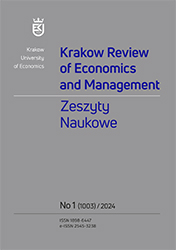Method of Collecting Non-interest Loan Costs and APRC Levels
DOI:
https://doi.org/10.15678/KREM.2024.1003.0108Keywords:
loan, non-interest loan costs, cost of debt, APRC, interest on interest, simple interest, compound interestAbstract
Objective: To assess how the method of collecting non-interest loan costs (NILC) impacts the Annual Percentage Rate of Charge (APRC), and to analyse how the specific structure of its formula impacts the APRC level depending on the method used to collect the NILC.
Research Design & Methods: Inductive reasoning and discussion of the effects of using selected combinations of NILC collection method for the APRC value in the case of loans repaid in installments. A case study is presented.
Findings: Postponing NILC payment reduces the APRC, as a result of which a loan with a higher NILC amount (but spread over time) may have a lower APRC than one with lower costs, but be payable at the time of loan disbursement. The method of settling the commission is important for the APRC level – whether it reduces the amount of the loan disbursed (yielding a higher APRC, because the costs are related to a lower amount of debt) or increases the debt. So it may turn out that while two offers seem the same, one may differ in how it settles NILC, despite the lower APRC, and prove more expensive (it will have a higher NILC amount, in other words). Similarly, loans with identical costs in PLN may have different APRC levels. A small change in the commission level may cause strong and varied changes in the APRC level – more or less than proportional to the change in the commission amount (depending on the length of the loan period), and be stronger or weaker (depending on the scale of NILC change).
Implications / Recommendations: The APRC does not allow debtors to make loan decisions correctly. This measure can only be used to compare the cost of loans granted on identical terms, i.e. for the same period of time, with the same frequency and with the same method of repayment of principal and interest installments and with the same method of collecting and settling NILC. In any other case, decisions made on the basis of the APRC may be wrong.
Contribution: The issue of APRC remains unexplored both in Poland and the EU, suggesting the research is innovative.
References
Czech, T. (2018). Kredyt konsumencki. Komentarz. Wolters Kluwer.
Dobosiewicz, Z. (2011). Bankowość. PWE.
European Commission. (2009). Study on the Calculation of the Annual Percentage Rate of Charge for Consumer Credit Agreements.
European Commission. (2013). Study on the Calculation of the Annual Percentage Rate of Charge for Consumer Credit Agreements. Revised.
European Commission. (2015). Examples For The Calculation of The Annual Percentage Rate of Charge For Credit Agreements For Consumers Relating To Residential Immovable Property.
Krzyżkiewicz, Z. (2001). Operacje banków uniwersalnych. W: W. L. Jaworski, Z. Zawadzka (red.), Bankowość. Poltext.
Prewysz-Kwinto, P. i Redo, M. (2022). Czy RRSO prawidłowo pokazuje rzeczywisty koszt kredytu ponoszony przez dłużnika? Studia i Prace Kolegium Zarządzania i Finansów, 187, 57–72. https://doi.org/10.33119/SIP.2022.187.3
Prewysz-Kwinto, P. i Redo, M. (2023). Czy RRSO pozwala na wybór najlepszej (najtańszej) oferty kredytowej? Ruch Prawniczy, Ekonomiczny i Socjologiczny, 85(2), 221–236. https://doi.org/10.14746/rpeis.2023.85.2.16
Redo, M. i Prewysz-Kwinto, P. (2022a). Nominalny Roczny Koszt Kredytu (NRKK) kontra myląco nazwana i niepoprawnie obliczana Rzeczywista Roczna Stopa Oprocentowania (RRSO). Studia i Prace Kolegium Zarządzania i Finansów, 185, 85–111. https://doi.org/10.33119/SIP.2022.185.5
Redo, M. i Prewysz-Kwinto, P. (2022b). Zrozumienie wskaźnika RRSO oraz jego rola w decyzjach kredytowych studentów – wyniki badania ankietowego. Przegląd Prawno-Ekonomiczny, 2, 149–172. https://doi.org/10.31743/ppe.13181
Redo, M. i Prewysz-Kwinto, P. (2023a). Czy kredytobiorcy kierują się poziomem RRSO? Wyniki badania ankietowego. Przegląd Prawno-Ekonomiczny, 1, 29–47. https://doi.org/10.31743/ppe.14462
Redo M. i Prewysz-Kwinto P. (2023b). Przykład reprezentatywny sposobem na manipulowanie RRSO w reklamie czyli kredytobiorcą. Państwo i Prawo, 9.
Redo, M. i Prewysz-Kwinto, P. (2023c). Ujemne RRSO sposobem na pozyskanie pożyczkobiorców. Studia i Prace Kolegium Zarządzania i Finansów (w druku).
Szymański, K. (2022). Co to jest prowizja? Ile wynosi w poszczególnych bankach? Pobrane z: https://direct.money.pl/artykuly/porady/co-to-jest-prowizja (data dostępu: 30.03.2022).
Ustawa z dnia 23 kwietnia 1964 r. – Kodeks cywilny (Dz.U. 1964 nr 16 poz. 93).
Ustawa z dnia 12 maja 2011 r. o kredycie konsumenckim (tekst ujednolicony na podstawie tekstu jedn. Dz.U. 2022 poz. 246, 2339).
Ustawa z dnia 6 października 2022 r. o zmianie ustaw w celu przeciwdziałania lichwie (Dz.U. 2022 poz. 2339).




